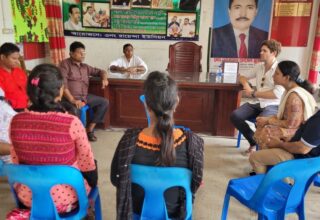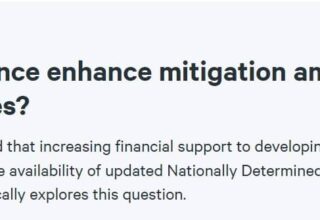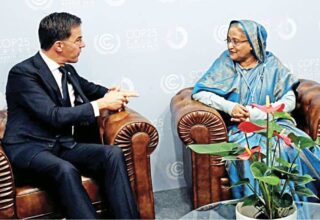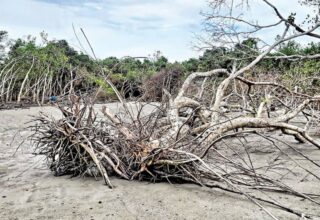(Originally published here)
As the implications of the Paris Agreement on Climate Change of 2015 become clear, financing of actions to tackle climate change on both the global and national level in every country will play a key role. These will, in turn, be influenced largely by the global and national political economy. In this article, I will try to give some personal insight on the matter of the political economy in which future climate change finance is likely to play out. This will include the main institutions involved, main drivers of change and where things are going.
GLOBAL LEVEL
At the global level there are two major areas of climate finance, namely mitigation (to support actions to reduce emissions of greenhouse gases) and adaptation (to support actions to cope with potential adverse impacts of climate change). There are also other areas such as afforestation and technology transfer, but these can also be largely divided into mitigation or adaption related activities.
There is another general categorisation that can be made, namely that mitigation actions are most relevant in large developing countries such as China, India, Indonesia, Brazil, South Africa and a few others that have the highest levels of greenhouse gas emissions to begin with. Support for adaptation, on the other hand, is a higher priority in the poorest and more vulnerable countries such as small island developing states (SIDS), Africa and the Least Developed Countries (LDCs), of which Bangladesh is one.
This does not mean that adaptation is not required in China, India and Brazil, etc. or that mitigation should not take place in LDCs and SIDS, but rather that the priority for international financial support for mitigation is logically to be directed at the larger developing countries while that for adaptation support should be directed at the poorer and more vulnerable developing countries.
GREEN CLIMATE FUND
The Paris Agreement has reiterated the pledge of the developed countries to provide USD 100 billion a year starting from 2020, when the Paris Agreement comes into force, to the developing countries to tackle climate change through both mitigation and adaptation. The developed countries also agreed that this amount would be a floor and not a ceiling and that it would be enhanced over time after 2020
The main, but not exclusive, vehicle for channelling most of these climate funds will be through the recently created Green Climate Fund (GCF), which has its own board and secretariat based in Korea. The GCF Board has met a number of times already and has made several significant decisions. The first one was to promise to allocate at least 50% of their funding towards adaption, especially in SIDS and LDCs. This is a significant decision in that current trends of global climate finance show that the balance of flows between mitigation and adaptation stands at 84% and 16% respectively, which is an unacceptable ratio from the perspective of the vulnerable countries.
The second important decision that the GCF board made at their last meeting in November was to approve the first set of eight projects worth several hundred million US dollars. One of these projects was for Bangladesh.
The GCF is likely to become the main channel for future climate finance from developed to developing countries, but it is by no means the only channel. I will briefly touch upon some of the other channels.
UNFCCC FUNDS
There are several other funds that have been set up under the UNFCCC over the years to channel global funds to support actions to tackle climate change in developing countries. These include the Least Developed Countries Fund (LDCF), which supports adaptation projects in only LDCs only; the Special Climate Change Fund (SCCF), which supports different kinds of actions in all developing countries; and the Adaptation Fund (AF), which supports adaptation projects in all developing countries. Each of these funds are under the UNFCCC, but they are managed by the Global Environment Facility (GEF) based in Washington DC, USA, and are composed of contributions from developed countries (although the AF also gets funded from the Adaptation Levy under the Clean Development Mechanism).
All of the funds still exist and may continue to do so until they are merged the GCF once it is up and running in full swing in a few years. However, these are matters still under discussion and will be decided on as time goes by.
BILATERAL AND MULTILATERAL CHANNELS
Another significant channel of funding from developed to developing countries are bilateral development assistance agencies such as DFID in the United Kingdom, USAID in the United States and GIZ in Germany, etc., as well as multilateral banks such as World Bank and Asian Development Bank (ADB) and UN agencies like UNDP, UNEP, FAO, etc.
These existing channels have traditionally been used to provide Official Development Assistance (ODA) from rich to poor countries, pre-dating climate change funding by several decades. However, as climate change funding becomes more prevalent, there has been a tendency for rich countries to combine development assistance with climate finance, which is problematic from the perspective of the developing countries receiving the funds.
Political economy of ODA versus climate finance
Under the UNFCCC, developed countries have agreed that climate finance will be “new and additional” to development assistance. However, in practice almost every developed country has mixed development finance with climate finance, double counting a significant amount of their contributions towards both their ODA pledges with their UNFCCC pledges.
One of the challenges of going forward after 2015 is to find ways to better monitor climate funding at the global level as there is no currently agreed-upon way of doing it and the method of self-certification adopted by the rich countries is severely flawed.
Thus counting which funds are for development assistance and which are for climate change support is going to remain a tricky political issue between the developed and developing countries.
PRIVATE FUNDING
Finally there are likely to be significant flows of private sector funds from developed countries to developing countries with investments into activities to tackle climate change. However, even here there is a very distinct pattern for private funding, which is basically profit making, to favour almost entirely investment in mitigation where there are profits to be made, rather than in adaptation where profits are not very likely.
NATIONAL LEVEL
In addition to funds from developed to developing countries, every country is also going to have to look at domestic funds to tackle climate change. This is particularly true for the more vulnerable countries that are already paying a very heavy price in terms of lost income and investments due to the severe adverse impacts of climate related disasters such as floods, droughts and hurricanes. Such impacts can take many percentage points off a country’s Gross Domestic Product (GDP) and will need to be calculated in order to align national budgets to minimise such losses in the future.
At the same time, social safety net programmes to protect the poorest citizens will also need to be aligned with climate vulnerability to ensure that the poorest and most vulnerable are protected from the adverse impacts of climate change.
In the energy, transport and industrial sectors as well, investments in cleaner energy sources will have to be weighed against similar investments in fossil fuels sources, whether indigenous or imported. In most cases it is becoming increasingly clear that investments in clean energy sources have many long term benefits, even if initial costs may be somewhat higher than that of fossil fuels.
Thus, over time, international funding for both development and climate change will have to be effectively blended with domestic sources of finance. For a poor and vulnerable country like Bangladesh, which nevertheless aspires to become a middle income country within less than a decade, it presents a number of challenges as well as opportunities which are discussed below.
NATIONAL LEVEL
In Bangladesh, the history of climate funding includes a combination of domestic funds, such as the Bangladesh Climate Trust Fund (BCTF), which has invested several hundred millions of US dollars of Bangladesh government’s own funds in hundreds of projects over the last six years; as well as the Bangladesh Climate Resilience Fund (BCRF), which has invested several hundred millions with funds contributed by developed countries such as the UK, Denmark, European Commission and Australia through their bilateral aid agencies.
In addition, Bangladesh has received funds from the LDC Fund, UNDP, UNEP, World Bank and Asian Development Bank amongst others.
Most of these funds, which total well over half a billion US dollars over the last six years or so, have gone towards supporting hundreds of projects under the Bangladesh Climate Change Strategy and Action Plan (BCCSAP).
Thus, Bangladesh has invested a significant amount of both domestic and international climate funding, mostly on adaptation, although there has also been a significant investment in solar energy systems for mitigation over the last few years.
POLITICAL ECONOMY OF CLIMATE FINANCE IN BANGLADESH
The main challenge of what to do next in channelling climate finance in Bangladesh is to decide whether or not to continue the parallel track of having the two separate climate funds, which fund projects bypassing the national planning system, or to mainstream or integrate climate financing into the national planning and budgeting systems.
I believe that the time has come for Bangladesh to transition away from stand-alone climate funds (like BCTF and BCRF) and mainstream or integrate climate change activities into national, sectoral and local development planning. This can be begun in the 7th Five Year Plan (FYP) from 2016 to 2020, which is about to start and will become fully mainstreamed by the time we plan and start the 8th FYP in 2021.
At the same time, the Finance Ministry, through the Economic Resources Division (ERD), can become the main channel for accessing global climate funds (primarily, but not exclusively through the GCF) and the Budget Division can track the climate finance expenditures through climate tracking systems that they have already developed.
The Independent Monitoring and Evaluation Department (IMED ) also needs to develop the ability to monitor the effectiveness of climate expenditure made by different government as well as non-government organisations on climate change activities.
This will all require good functional co-operation between different entities within and outside the government, for example, between the ministries of Planning and Finance with other line ministries, especially the Ministry of Environment and Forests (MOEF). It will also require good co-operation between the central and local governments and between executive and legislative branches of the government.
Among important non-government actors are the many NGOs working at the grass roots level, media organisations, the private sector and the university sector. All the different actors will need to play their respective parts in order for Bangladesh to be able to effectively meet the twin challenges of escaping poverty and tackling climate change.
Fortunately, when it comes to tackling climate change, there is hardly any difference between the major political parties on the importance of tackling it successfully. Tackling climate change may even present a real opportunity for political parties to try to join forces in the national interest rather than oppose each other as they do on most other issues.
Written by: Saleemul Huq, Director, ICCCAD







